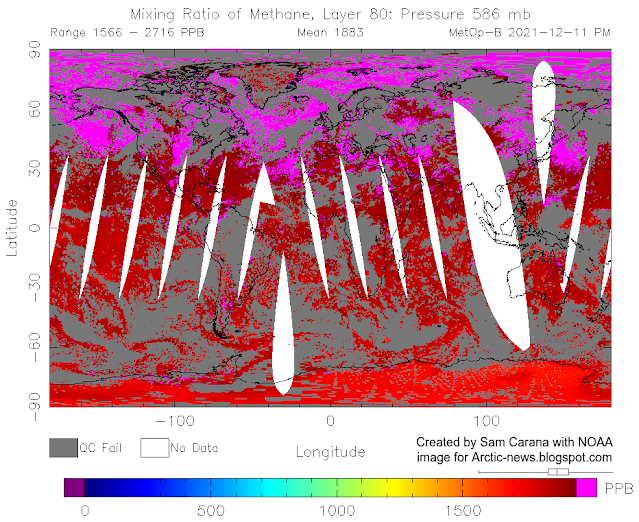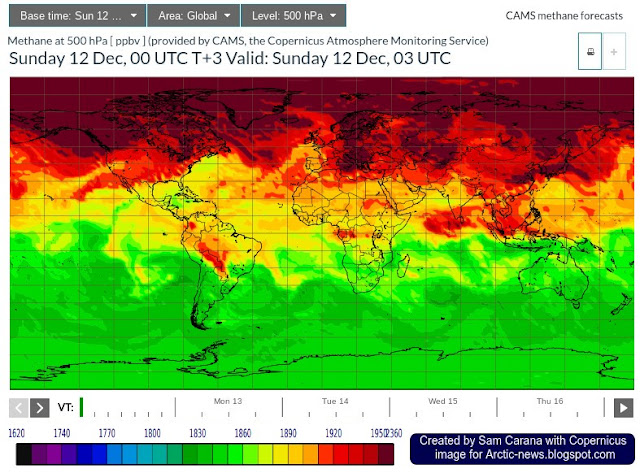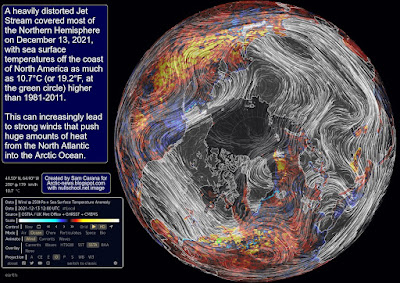 |
| [ discussed at facebook ] |
The above image, adapted from Climate Reanalyzer, and the image below, adapted from NASA, both use the same 1951-1980 baseline to illustrate the October 2023 temperature anomaly.
Anomalies are very high, especially over the Arctic Ocean, which reflects the enormous amounts of heat that are transferred from the Arctic Ocean to the atmosphere.
There are further reasons behind the very high anomalies over the Arctic, one of which is methane, which has risen very fast over the years.
The image on the right illustrates methane's historic rise, showing IPCC and, more recently, WMO data. Methane (CH₄) reached 1923 parts per billion (ppb) in 2022, 264% of the 1750 level, while carbon dioxide (CO₂) reached 417.9 parts per million (ppm) in 2022, 150% of the 1750 level, and nitrous oxide (N₂O) reached 335.8 ppb, 124% of the 1750 level.

The image below shows high monthly methane levels at Mauna Loa, Hawaii, U.S.
The image on the right illustrates methane's historic rise, showing IPCC and, more recently, WMO data. Methane (CH₄) reached 1923 parts per billion (ppb) in 2022, 264% of the 1750 level, while carbon dioxide (CO₂) reached 417.9 parts per million (ppm) in 2022, 150% of the 1750 level, and nitrous oxide (N₂O) reached 335.8 ppb, 124% of the 1750 level.
This image below shows some very high hourly average methane levels recently recorded at Barrow, Alaska.

The image below shows high monthly methane levels at Mauna Loa, Hawaii, U.S.
The image below, created with a Copernicus forecast for November 15, 2023 03 UTC, shows very high methane levels over the Arctic at 500 hPa.
The image below shows that the NOAA-20 satellite recorded high methane levels over the Arctic Ocean, especially north of Alaska, on November 15, 2023 AM at 399.1 mb.
The image below shows methane levels as high as 2700 ppb recorded by the MetOp-B satellite on November 17, 2023 PM at 293 mb.
The image below shows high methane levels over Greenland recorded by the MetOp-B satellite on November 18, 2023 PM at 399 mb.
The image below shows mean methane levels of 1942 ppb recorded by the MetOp-B satellite on November 19, 2023 PM at 399 mb.
 |
| [ click on images to enlarge ] |
 |
| [ click on images to enlarge ] |
 |
| [ from earlier post ] |
Over the next few months, as sea ice keeps growing in extent, this seals off the Arctic Ocean from the atmosphere. This makes it harder for heat to get transferred from the Arctic Ocean to the atmosphere and increases the danger that more heat will reach sediments located at the seafloor and cause methane to be released from hydrates as well as methane that is present in the form of free gas underneath the hydrates.
The danger is illustrated by the image below, adapted from Climate Reanalyzer, which shows a rise in temperature (2 m) by 2100 compared to 1852-1900 using a CMIP6 SSP585 model.
 |
| [ image from the Extinction page ] |
Note that none of the bases used in the above images is pre-industrial, neither 1880-1920, nor 1951-1980, nor 1852-1900. Using a base that is genuinely pre-industrial base would result in even higher anomalies. The image on the right shows a 2.29°C 2020 anomaly from 3480 BC.
Note also that even a small temperature rise (of less than 1°C) can destabilize a vulnerable methane hydrate, which can cause an eruption that in turn can destabilize neighbouring hydrates, resulting in a self-reinforcing feedback loop of methane releases, including methane in the form of free gas from underneath the hydrates. This can drive up temperatures very rapidly.
Conclusion
The precautionary principle calls for comprehensive and effective action to reduce the damage and to improve the situation, along the lines of this 2022 post in combination with a declaration of a climate emergency.
Links
• Climate Reanalyzer
https://climatereanalyzer.org/research_tools/monthly_maps
• NASA Temperature anomaly October 2023
• WMO Greenhouse Gas Bulletin No. 19 – 15 November 2023
• Copernicus - Methane forecasts
• NOAA - Carbon Cycle Gases - Barrow Atmospheric Baseline Observatory, United States
https://gml.noaa.gov/dv/iadv/graph.php?code=BRW&program=ccgg&type=ts
• NOAA - Carbon Cycle Gases - Mauna Loa, Hawaii, United States
• NOAA - Carbon Cycle Gases - Mauna Loa, Hawaii, United States
https://gml.noaa.gov/dv/iadv/graph.php?code=MLO&program=ccgg&type=ts
• NOAA-20 satellite
https://www.ospo.noaa.gov/Products/atmosphere/soundings/heap/nucaps/new/nucaps_products.html
• NOAA-20 satellite
https://www.ospo.noaa.gov/Products/atmosphere/soundings/heap/nucaps/new/nucaps_products.html
• NOAA MetOp-B satellite
https://www.ospo.noaa.gov/Products/atmosphere/soundings/heap/iasi/iasiproducts.html
• Extinction
• Pre-industrial
• Transforming Society
https://arctic-news.blogspot.com/2022/10/transforming-society.html
• Climate Plan
https://arctic-news.blogspot.com/p/climateplan.html
• Climate Emergency Declaration
https://arctic-news.blogspot.com/p/climate-emergency-declaration.html
• Climate Plan
https://arctic-news.blogspot.com/p/climateplan.html
• Climate Emergency Declaration
https://arctic-news.blogspot.com/p/climate-emergency-declaration.html
















































